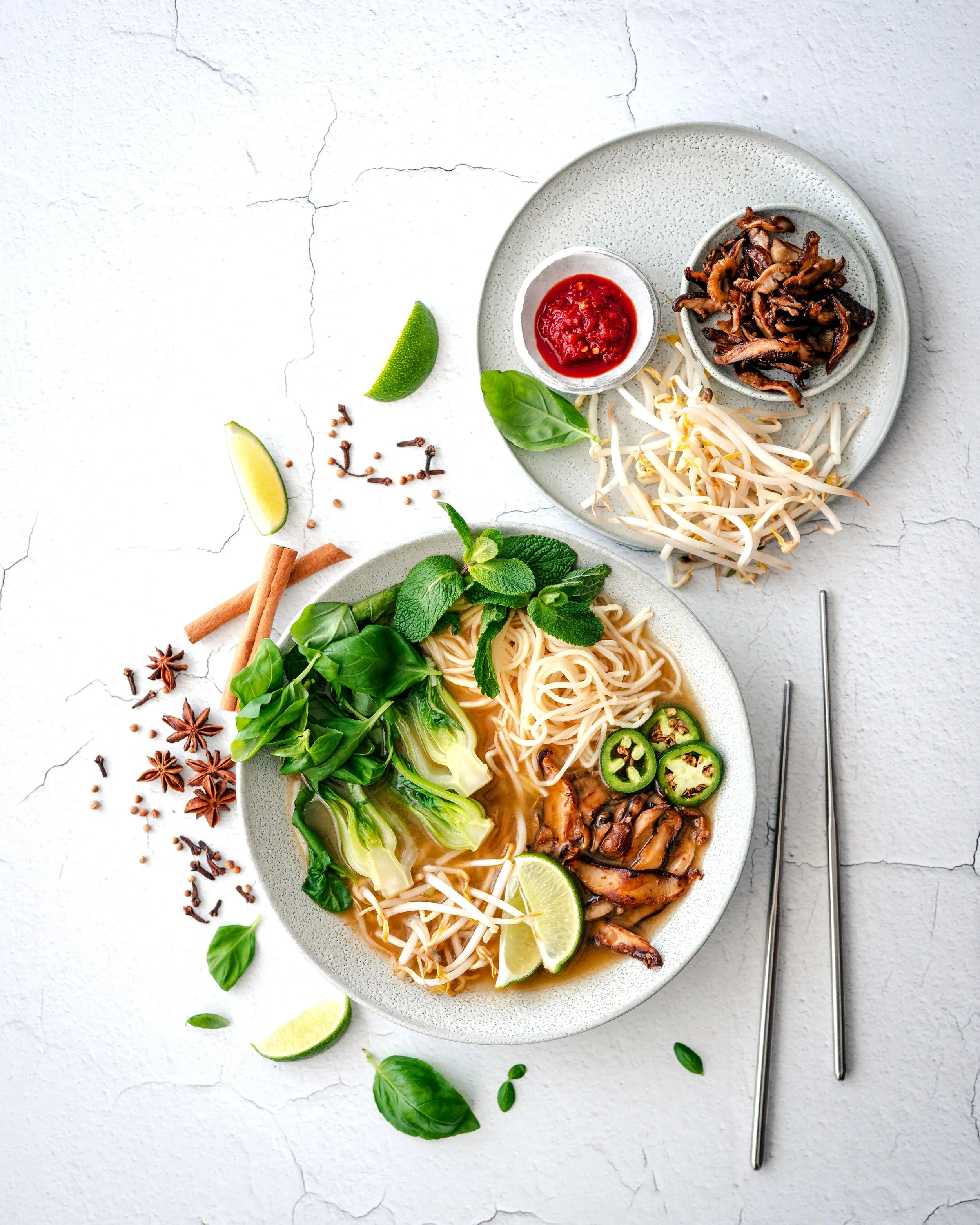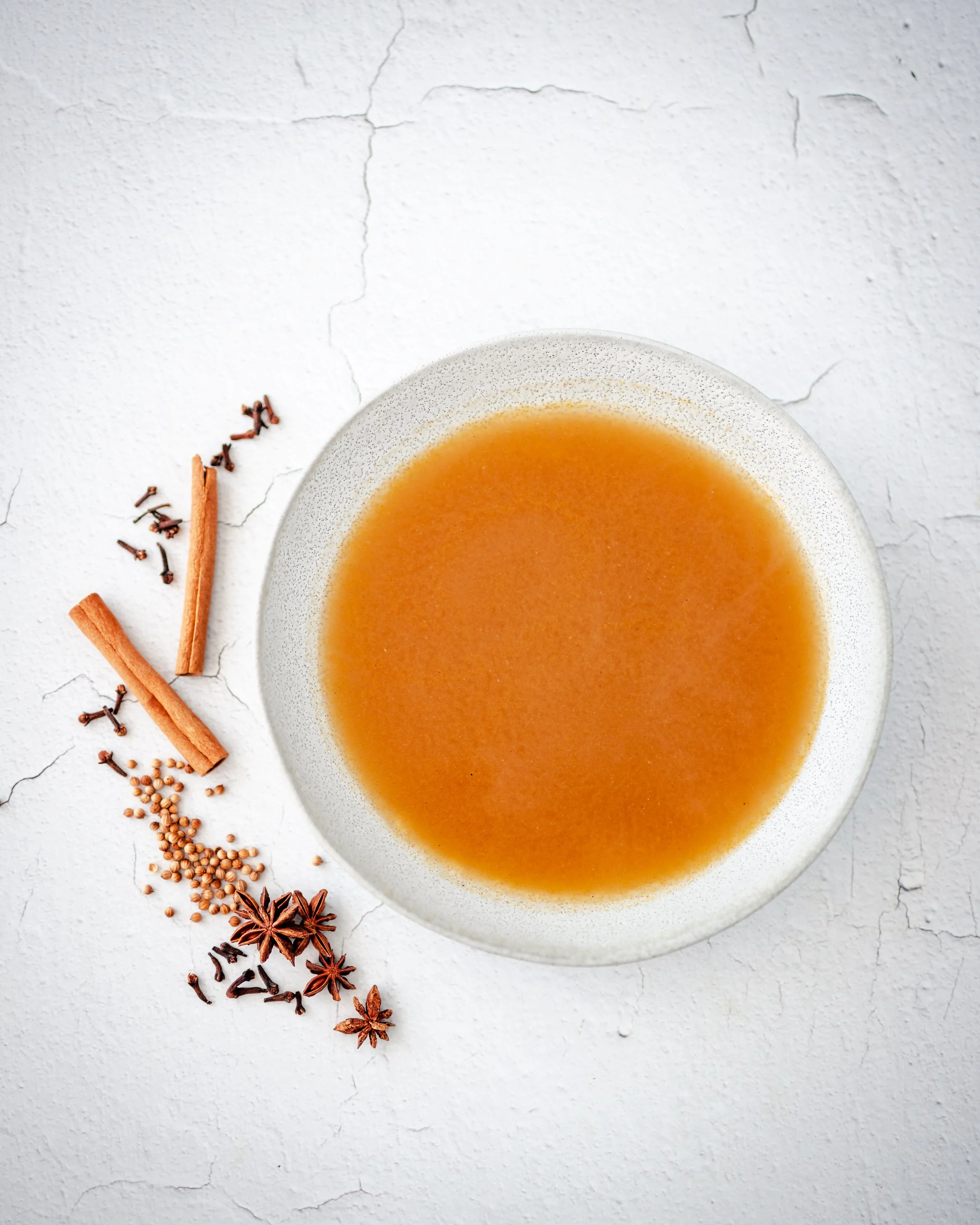VIETNAMESE PHO SOUP

This traditional Vietnamese noodle soup has been a favorite of mine since the pandemic- everything, including restaurants were closed and I just decided to start making it at home for myself!
For me, a winning pho recipe all boils down (quite literally) to the quality of its broth. I like the broth because of all the flavours- the cozy blend and special aroma that comes from this soup makes it so yummy. But while the broth is traditionally beef stock, I use homemade chicken stock. I truly love this recipe and I think all my soup-lovers out there will, too!
VIETNAMESE PHO SOUP
THE INGREDIENT BREAKDOWN:
Steak: Pho bo is traditionally made with thinly sliced steak that is cooked in the simmering broth in each individual serving bowl. However, mine is vegetarian.
Thin rice noodles: Pho is traditionally made with thin rice noodles, such as these. In order to prevent the noodles from overcooking in the broth, it’s traditional to cook pho noodles separately on their own. Then the noodles will be added to each individual serving bowl, followed by the protein, hot broth and toppings. I use Lotus & Food organic Millet & Brown Rice Ramen noodles or the Palmini Hearts of Palm noodles.
Spices: There are 4 important spices in pho broth — star anise, whole cloves, cinnamon sticks, and coriander seeds. I really recommend using the whole (not ground) spices if possible, which we will briefly toast to bring out extra flavor. But I have also included notes below for using ground spices, if those are what you have on hand.
Fish sauce: It’s traditional to add just a little splash to the broth.
Toppings, toppings, toppings: This is one soup recipe where the toppings are not optional. Rather, the toppings are the stars of the soup! Feel free to pick and choose your favorites, but I recommend at least one from each category:
Fresh herbs: The more the merrier! I recommend a combo of fresh cilantro, fresh mint and fresh Thai basil (or you could sub Italian basil, in a pinch).
Bean sprouts: You can find these in the produce section of your grocery store, or they are always available in southeast Asian groceries.
Lime wedges: Essential for brightening up the flavors of the broth.
Chiles (optional): Thai bird chiles are traditionally used to give the soup your desired amount of heat, but you could also use jalapeños or serrano peppers too.
Onions (optional): Either sliced green onions or super-thinly-sliced white onions as a garnish.
Sauces (optional): It’s also traditional to serve pho with hoisin sauce and/or sriracha to use as a garnish if desired.
**You can also add a protein; steak, chicken or shrimp would be great!
INGREDIENTS
BASE
1 large white onion, peeled and halved
3-inch piece of fresh ginger, halved lengthwise
5 star anise
4 whole cloves
3 (3-inch) cinnamon sticks
1 tablespoon whole coriander seeds
8 cups good-quality homemade chicken stock (or beef, or vegetable)
2 teaspoons fish sauce
Fresh herbs (cilantro, basil leaves, mint leaves)
Fresh bean sprouts (if your grocery store doesn’t carry these check your local asian grocery store).
Lime wedges
Sriracha hot sauce
PHO SOUP INGREDIENT & GARNISHES:
7 ounces uncooked thin rice noodles
Grilled mushrooms
Optional: Steamed mini bokchoy
Garnishes: these are what make pho soup really shine!
Green onions
Fresh jalapeño peppers or red Thai chili peppers
INSTRUCTIONS
Char the onions and ginger. Turn the oven broiler to high, and place the baking rack about 8 inches away from the heating elements. Place the onion and ginger cut-side-up on a baking sheet, and brush with a bit of oil. Broil for about 7-10 minutes, until the tops of the onion and ginger are slightly charred. Remove and set aside.
Make the broth. Meanwhile, heat the anise, cloves, cinnamon, and coriander to a large stockpot over medium-high heat for about 3 minutes until fragrant. Add in the charred onion, ginger, stock, and stir to combine. Continue cooking until the broth reaches a simmer. Then reduce heat to medium-low, cover with a lid, and continue to simmer for at least 30 minutes. Strain out (and discard) the onions, ginger and spices. Stir in the fish sauce and sweetener into the hot broth. Then finally, taste and season the broth with salt as needed.
Prep the noodles. Meanwhile, as your broth is simmering, cook the noodles separately al dente according to the package instructions. Drain in a strainer, then briefly rinse the noodles with cold water to prevent them from continuing to cook. (I also recommend tossing the noodles with a drizzle of oil — such as sesame oil — to prevent them from sticking.)
Assemble. Now the fun part! Add a handful of noodles to each individual serving bowl, the sprouts, the bok choy & the mushrooms in the bowl. Then ladle the still-simmering hot broth into the serving bowls, top each bowl with lots and lots of garnishes, and finish with a squeeze of lime juice.
Serve immediately. Encouraging everyone to stir the garnishes into the soup so that they can flavor the broth, also adding in additional extra sauces if desired.
HOW TO SERVE/EAT:
Pho soup is traditionally served in large soup bowls with chopsticks and a soup spoon. But that said, feel free to use whatever bowls you happen to have on hand at home. First, use your chopsticks to stir all of those yummy fresh garnishes into the broth to help give it extra flavor. Then- use your chopsticks to eat the noodles, protein and veggies, while using your spoon to eat the broth.
Make ahead instructions: The broth can be made several days ahead of time. Allow it to cool, cover it and store it in the refrigerator. Reheat on the stove.
HOW TO STORE:
The broth can be made several days ahead of when you want to serve. Store in the fridge & reheat on stove.
For long periods: freeze only the broth. Allow it to cool completely before and store in a freezer safe bag or container for 4-5 months.
Click here to shop for kitchen items & tools used in this recipe & some more of my go-to faves!
BON APPETIT!
Photography by Patricia Brochu



